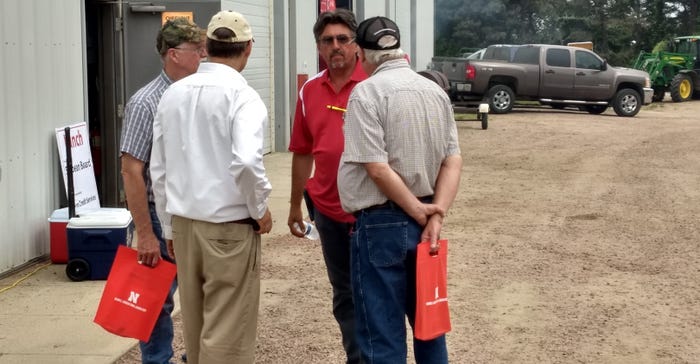
The soils and weather patterns in research fields at the University of Nebraska Haskell Agricultural Laboratory near Concord are normal for northeast Nebraska, but unique to the rest of the state.
“Locally, our weather here is very different than other parts of the state,” Nebraska Extension weed scientist Stevan Knezevic told crowds attending his workshop on Nebraska weeds at the first Climate and Crops Family Field Day hosted at HAL recently.
“This is perhaps the coldest part of the state,” Knezevic said. “We are often about a month later in the planting and cropping season than farmers to the south. Our part of the state is unique, and our soils are colder.”
“We also have colder nights. That’s important, because of the chemistries involved in some of our pesticides,” he said. “If the night temperatures are colder in late April and early May, this might impact the efficacy of our burndown herbicides, for instance.”
Knezevic said the research being conducted at HAL was well-received. Nearly 400 people attended the first-ever, all-day family event, and showed interest for the work being conducted at an agricultural research laboratory that was embattled in a budget fight as recently as this spring.
HAL was listed as a target for closure earlier in 2018 when UNL leaders struggled to comply with a request from Gov. Pete Ricketts to reduce the current UNL budget by 4%, due to lower-than expected tax receipts. The reprieve came when the Unicameral passed a budget during this past session requiring a reduction of 1%, allowing HAL to stay off the list for cuts.
Prior to the budget concerns of the spring, staff at HAL had already started forming a model in 2017 to develop areas at the lab that would allow researchers and Nebraska Extension to interact and teach youth and adults about food production systems in both beef and crops, said Bill Kranz, associate director of the Northeast Extension District. “In addition, the surface drain running through the farm provides opportunities for looking more closely at aquatic life,” he adds. “A pollinator garden is being discussed, and the Mobile Beef Lab is another area that teaches youth about how animals convert vegetation to the food we eat.”
It's all part of the mission at HAL. “I believe that part of our mission is to provide these opportunities,” Kranz said. “The overall idea of the field day was to showcase the education and research programs being conducted in northeast Nebraska and to get our Nebraska Extension educators more involved in what happens at the lab.
“Our educators responded in an extremely strong manner at our field day. I feel that the seed has been planted to allow and encourage them to participate and to schedule similar events at HAL.”
Kranz said they hope for more daylong events at HAL that combine the aspects of UNL teaching, research and Nebraska Extension programs.
Knezevic highlighted one aspect of the unique cropping research being conducted at HAL. He said that rainfall events have become more extreme since he joined the staff there 20 years ago. Resistant weeds are still the main concern for weed scientists, he said. Waterhemp is resistant to three modes of action in the state, and Palmer amaranth is resistant to two. These are the kinds of issues that farmers and weed scientists are facing.
Knezevic has also been involved in battling aquatic invasive weed species in northeast Nebraska, like purple loosestrife along the Missouri River and Niobrara River basins. “I’m probably one of the few weed scientists in this part of the country with a boat,” he joked.
Weather and climate do not just impact crops. Nebraska Extension beef specialist Rick Stowell told field day guests that weather plays a crucial role in the success of beef producers. Through survey results from focus groups of beef producers, researchers have learned more about how weather impacts beef operations. “We asked these producers to share their weather stories,” Stowell said. “One comment was that more cows were lost to wet weather than to drought, because of flooding and severe events.”
While weather wasn’t necessarily ahead of other management concerns like economics, taxes and regulations and local ranch conditions, extreme weather was on the radar. Some weather scenarios are better than others, in the minds of producers, Stowell said. Cold and dry conditions in late winter and early spring are good for cattle producers at the time, but might not bode well for the summer and fall months. “You have to think about the system overall,” Stowell said. “Cold and wet winter and spring weather are bad, because of the mud, health and transportation issues with cattle.”
Warm and wet conditions, when temperatures are around freezing, are bad for feedlots. Warm and dry conditions are the best overall for cattle producers in winter and spring, but Stowell said that these conditions can lead to more problems with forages later in the year.
Each operation is different when it comes to dealing with weather. “We need to think more broadly to work on specific needs of producers,” he explained. “We need to come up with management strategies to help with the day to day operations.”
Michael Boehm, vice chancellor of the UNL Institute of Agriculture and Natural Resources, and Al Dutcher, Nebraska Extension agricultural climatologist, were noon luncheon speakers at the event. There were also numerous ag and conservation related vendors and exhibits, along with an arboretum tour, research plot tours at HAL, youth activities and a drilling rig demonstration.
About the Author(s)
You May Also Like






